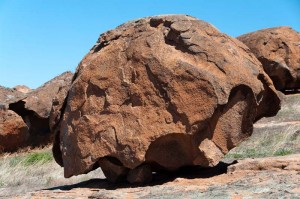Yesterday, March 5, we travelled northwest to Port Augusta. It’s the fourth time we’ve been through the town. It’s hard to go across Australia without going through there, as it is the hub that connects major highways from all four compass directions.
Also we are once again warm. Today it reached a high of 37 ºC here in Ceduna (our destination today) but it has cooled off nicely now to the mid twenties. We ate outside tonight for the first time in over a month.
This morning we drove by the town of Iron Knob about 65 km to the west of Port Augusta. This is a large open pit iron mine. We didn’t drive in to the town (there is a sign saying mine tours were available) but from the highway, which is at least five kilometres from the hill, you can see the huge contours of where they have mined the ore. Since the mine first opened in 1899 they have taken over 150 m off the top of the mountain.
Next we stopped in Wudinna for fuel, lunch, and to photograph the large granite sculpture “The Australian Farmer “. They quarry granite in this area, and the monument is a very large sculpture representing a farmer, heads of grain, sheep and other items of agriculture. It is an impressive sculpture over 9 metres tall.
Next we went to Pildappa Rock which is about 15 km north of the town of Minnipa. We weren’t sure what to expect from the rock (or the road) but were very surprised. The road was gravel but the best one we’ve been on in Australia, wide and smooth. The rock is very large, about 200 metres across and almost 20 metres high. It has eroded into a wave shape, and has a number of large boulders at the top. It also has several shallow eroded pans (gnammas rockholes), a couple of which are full of water. There is also an old dam in one of the eroded trenches on the rock. The rock is an example of an inselberg, the underlying rock pink granite, and covered with darker lichens.
We drove back to another rock nearer the town. This rock, Tcharkulda Rock, isn’t as eroded into the wave form of Pildappa, but it has two interesting features. In the early 1900’s the settlers in the area built a stone wall at the bottom of the rock, and an aqueduct that goes into a small reservoir. About half the rock, an area of about an acre, would drain into this reservoir. The top of the rock is covered with very large eroded boulders. Many of the boulders have interesting hollowed out areas so that they look like they are sitting on legs. Some of the hollows are large enough to shelter under, and I’m sure that the aboriginal people must have used them for that purpose in the past. Although I looked hard, I could see no sign of any rock painting though.
From up on the rock you could see that there was an animal standing in the aqueduct in the shade of an old building. It looked to me like a goat, but when I walked down to take a picture of the aqueduct it ran away to the far end. I could then see that it was a small sheep. It tried to climb up the concrete wall of the aqueduct, but couldn’t and collapsed right away onto the ground. I walked up to it and picked up the poor frightened lamb by the scruff of the neck, and lifted it out. It couldn’t have weighed more than 15 pounds, and was in very poor condition, barely able to walk even after I got it out. It had been trapped in the aqueduct as it was gated on both ends, and the two foot depth was more than it was able to get up over. I’m not sure if it will survive, though since it was now in a farm yard it might if it could find water.


